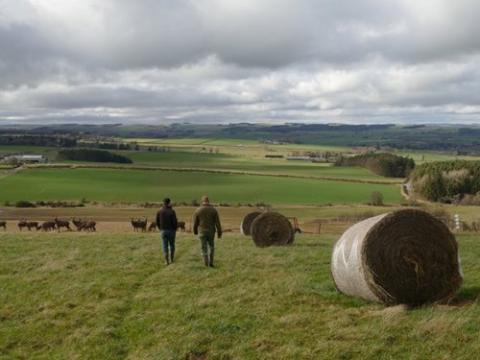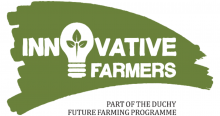Photo: Angus Birditt, Pasture for life
The new field lab with Innovative Farmers is investigating bale grazing, a common practice in North America and Canada, where bales are put out in summer to feed cattle through winter.
It allows continuation of mob grazing from the warmer months, where the farmer can fence off each bale so the livestock can access one area at a time. This allows the rest of the field to recover after the herd has moved on.
The six farms involved in the trial are already seeing success in proving this method as a nature-friendly and cheaper alternative to housing cattle overwinter and to current common overwintering practice.
Winter grazing usually involves feeding cattle on a “sacrificial field” of a single fodder crop like turnips, which means ploughing up permanent pasture for a crop with no commercial value.
The cattle often make a mess of the field, causing soil erosion, but bale grazing should return carbon and nutrients to the soil via trampled hay.
Trial co-ordinator and participant Nikki Yoxall, a farmer in Aberdeenshire who keeps a herd of native cattle, said: “The benefits of bale grazing have barely been explored in the UK – we hope to investigate how these changes can open new welfare and commercial avenues for farmers.
"There are farmers in the field lab who used to house cattle and are now using bale grazing as a way of outwintering, and they are already seeing cost reductions in terms of labour, fuel, machinery, and housing.
“Initiatives like these put control in the hands of the farmers. Working with Innovative Farmers, we hope to show that bale grazing can have positive effects across several farm and soil types and encourage other farming communities to make positive changes.”
Can bale grazing boost for nature and animal welfare?
The field lab is being supported by Innovative Farmers, a network that enables farmer-led research, and the triallists hope to improve soil health and animal welfare.
Triallists are testing the theory that the trampled hay provides food and supports habitats for nature like earthworms, dung beetles, birds, and voles, as well as potentially boosting the yield of the permanent pasture when spring comes.
This is in stark contrast to overwintering indoors where hay and manure become waste products. It also provides an alternative to ploughing up permanent pasture, which often results in run off into water catchments.
The field lab is monitoring changes in soil quality, and it is hoped bale grazing can help to avoid negative impacts on soil structure. Soil and forage samples will be taken in August 2023 and every summer until 2026.
Case study: bale grazing provides cost savings and a more holistic farming system
Organic tenant farmer Silas Hedley-Lawrence manages a herd of around 300 beef and dairy store cattle on heavy clay and flood plains just outside Oxford.
As part of the Food Animal Initiative (FAI) Farms project, he monitors soil health and nature across the entire farm to provide information on regenerative farming for large global food suppliers.
He has been bale grazing his cattle for four years and joined the field lab to gain specific data on what this practice is delivering for the farm.
He reports a reduction in costs of around two-thirds per head using this approach, with a current spend of around £1 per animal per day, compared to the national average of £2.40 per head for housing cattle.
He added: “We farm on clay on flood plains and most people will say you can’t overwinter cattle on that. Not only are we doing it but we’re doing it as a tool to increase biodiversity and regeneration.
“The perception of what outwintering involves is so different to the reality of what we see here. We aren’t wrecking or sacrificing any fields. If it can work on our wet, heavy soils then it’s certainly an option for other farmers to use as a regenerative tool.”
Silas has a mob grazing system with tall grass grazing in the warmer months and bale grazing in the winter. The cattle are in a fenced off cell for a short period, usually one day, all year round.
He added: “There are cost savings, but they don’t take into account the wider benefits. It’s a holistic system where we are using the cattle as a regenerative tool to trample seeds into the ground. We don’t have to muck out sheds in spring, or reseed, or sort out any trashed fields.
“The pasture comes back each year more diverse and more productive – in May and June the area will be awash with wildflowers and herbs.~
“The experiment has been great for wildlife on the farm. We’ve seen increased numbers of cattle egrets with the herd over the last two winters, and due to the additional manure dung beetles are bouncing back quite noticeably. Barn owls and hares were rarely sighted before and are now commonplace.”
Bale grazing provides a low-risk solution
The farmers also hope to inspire others by demonstrating bale grazing as a low-risk solution. This is because the housing system can be implemented as a backup, particularly if the farm still has a shed.
They are also hoping to demonstrate animal welfare benefits as overwintering indoors generates a higher risk of illness like pneumonia due to moisture levels. As cattle can comfortably live at -10°C without needing to warm themselves up often housing isn’t necessary.
Innovative Farmers Manager Rebecca Swinn said: “The potential environmental benefits of the bale grazing trial cannot be overstated. Feeding manure back into the soil encourages vital insects to work over winter, increasing the health of the soil and providing food for birds and mammals.
“Results from the field lab could also have far-reaching implications for farm businesses, as less energy is lost through labour and fuel, saving money for use elsewhere on the farm.”



